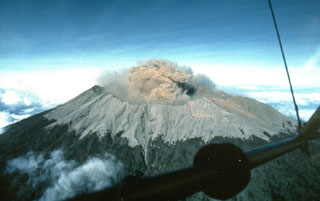Report on Raung (Indonesia) — 11 December-17 December 2024
Smithsonian Institution / US Geological Survey
Weekly Volcanic Activity Report, 11 December-17 December 2024
Managing Editor: Sally Sennert.
Please cite this report as:
Global Volcanism Program, 2024. Report on Raung (Indonesia) (Sennert, S, ed.). Weekly Volcanic Activity Report, 11 December-17 December 2024. Smithsonian Institution and US Geological Survey.
Raung
Indonesia
8.119°S, 114.056°E; summit elev. 3260 m
All times are local (unless otherwise noted)
The Pusat Vulkanologi dan Mitigasi Bencana Geologi (PVMBG) issued a Volcano Observatory Notice for Aviation (VONA) for Raung at 1751 on 12 December, noting that white plumes rose 500 m above the summit and volcanic tremor was recorded by the seismic network. Increasing volcanic activity prompted the release of another VONA at 2003 on 15 December; the Aviation Color Code was raised to Yellow (the second lowest color on a four-color scale). An eruptive event produced a medium-dense to dense ash plume that rose 500 m above the summit and drifted E and SE. According to the Darwin VAAC the ash plume had dissipated by 0940 on 16 December. The Alert Level remained at 2 (on a scale of 1-4) and the public was warned to stay 3 km away from the summit crater.
Geological Summary. Raung, one of Java's most active volcanoes, is a massive stratovolcano in easternmost Java that was constructed SW of the rim of Ijen caldera. The unvegetated summit is truncated by a dramatic steep-walled, 2-km-wide caldera that has been the site of frequent historical eruptions. A prehistoric collapse of Gunung Gadung on the W flank produced a large debris avalanche that traveled 79 km, reaching nearly to the Indian Ocean. Raung contains several centers constructed along a NE-SW line, with Gunung Suket and Gunung Gadung stratovolcanoes being located to the NE and W, respectively.
Sources: Pusat Vulkanologi dan Mitigasi Bencana Geologi (PVMBG, also known as CVGHM), Darwin Volcanic Ash Advisory Centre (VAAC)

